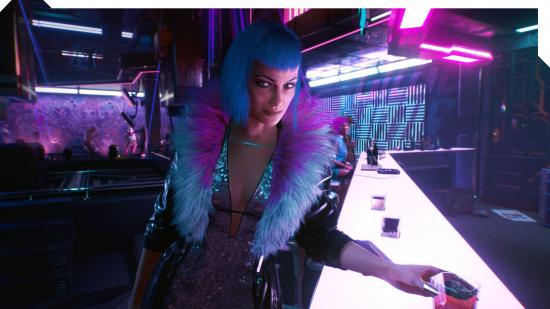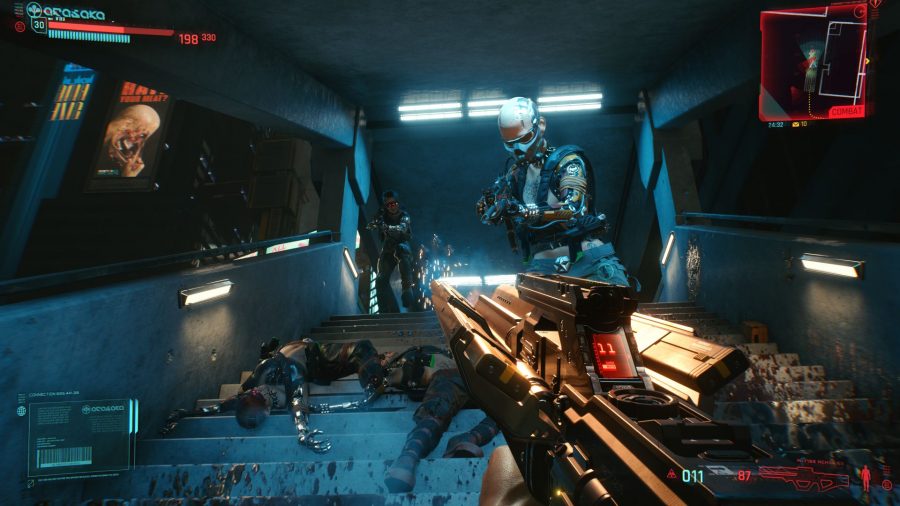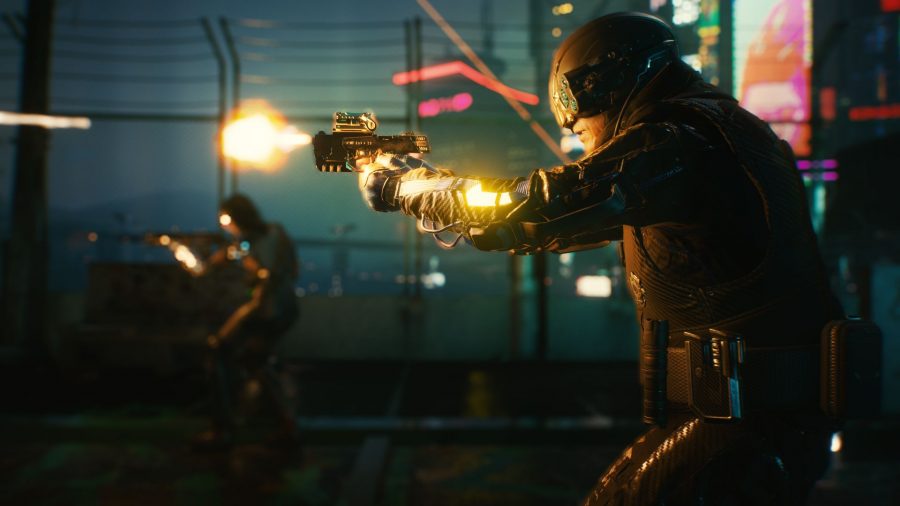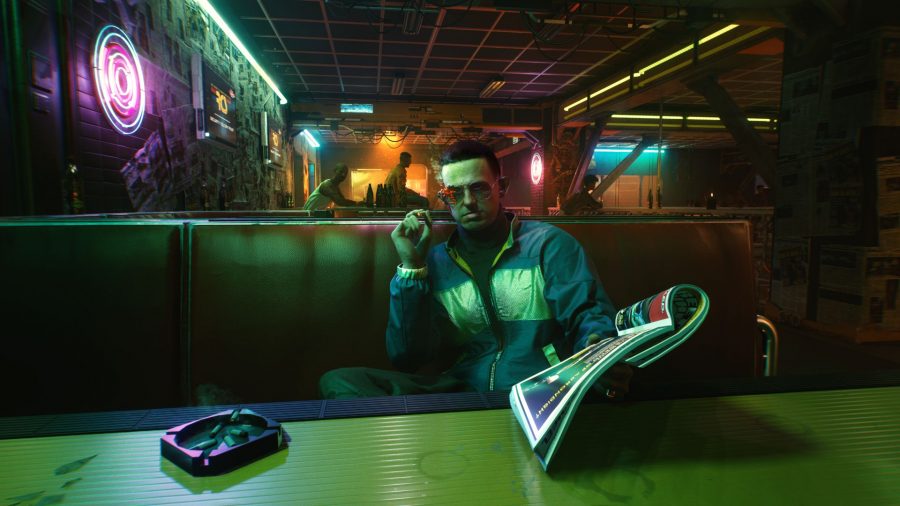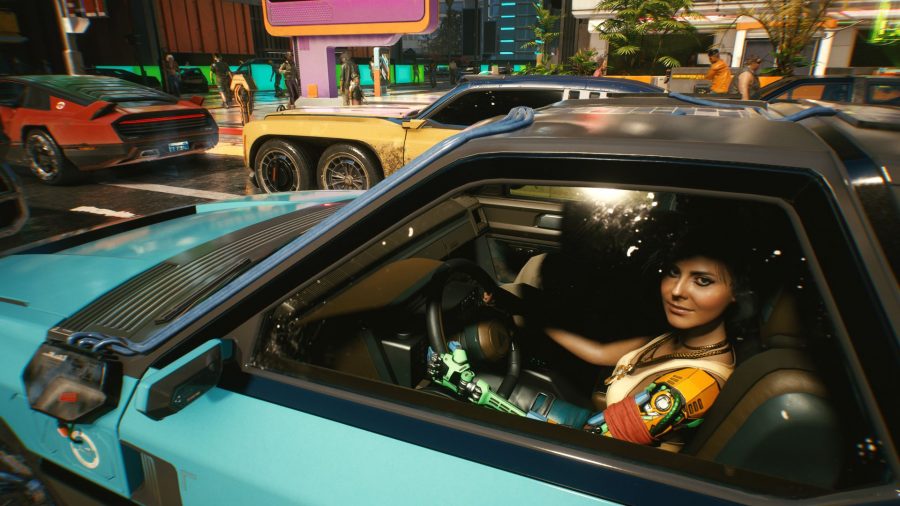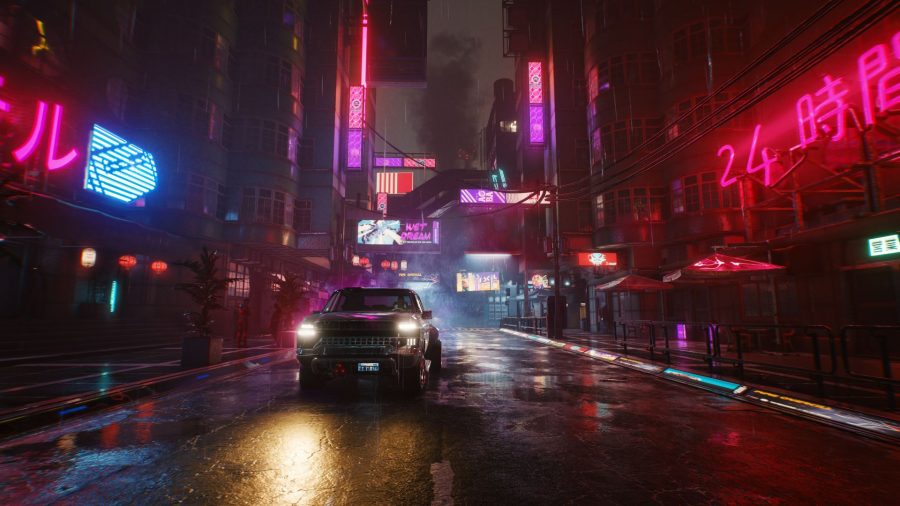Cyberpunk 2077 has some of the best bars in videogames. You can find them tucked away in practically every borough of the megapolis of Night City. There's the legendary Afterlife, a meeting place for the mercenary elite buried beneath the brutalist architecture of Watson's Kabuki district. It's brightly lit so local celebrities can be seen, the music is quiet enough to allow for conversation, and private booths comprise its perimeter. It's the Cyberpunk equivalent of a Sunset Strip celebrity haunt.
By contrast, Lizzie's Bar – one of the first locations I visit during a four-hour hands-on session with the game – is proudly, defiantly vulgar. The kitschy dive has private braindance booths in the back serving clients' sexual fantasies. Slogans like 'Lizzie jizzie' and 'fuck to death' adorn the walls, industrial music blasts from speakers, and oppressive strobe lighting keeps you on edge the second you step inside.
One thing that's difficult to glean until you actually go hands-on with Cyberpunk 2077, is just how immersive its first-person perspective is. And in these bustling hubs of revellers and dealers, that sense of place comes through crystal clear.
The only reason that I’m in Lizzie’s is that I chose the Corpo life path for protagonist V’s backstory. After picking up my orders from my boss at the Arasaka megacorp, I take a shuttle from the wealthy Arasaka Towers in the City Center down to the poverty-stricken streets of Watson to Lizzie’s, where I try to enlist the cheerful, charming Jackie Welles for the latest Corpo gig.

The journey there is straight out of Blade Runner. A luxurious, fully automated shuttle gracefully descends through the smog, panning across the Night City skyline. Billboards scream for attention offering everything from energy drinks to ‘sexploitative’ braindance experiences like ‘wet dream’. There are even gas flares spitting fire out across the horizon – the only thing missing is the glittering synth of Vangelis.
As a Corpo, my V starts off with a haul of cyberware that ordinary civilians can’t compete with. Its superiority is immediately demonstrated when we land on the roof of Lizzie’s and interrupt a basketball game. When one of the players confronts us, we grab the ball, knock them out with it, and make a perfect three-point shot before strolling over to the bar’s entrance.
Had I chosen Street Kid my journey would’ve started in Heywood’s El Coyote Cojo dive bar, whereas the Nomad life path begins in the dusty Badlands, haring across the desert highway with Night City in my sights. No matter the life path you choose, it’s not long until they converge and you find yourself in Watson, partnered with Jackie.
Unlike most FPS games, the environments of Night City don’t feel like potential arenas. Spaces are much tighter, and there’s less room between you and NPCs. Many of the key dialogue scenes in the demo take place at Night City bars, and you’re always in very close proximity to whoever you’re talking to. The effect is that you feel locked into these conversations, whether it’s listening to your partner’s philosophical ruminations, making small talk with the bartender, or your picking up key information on your next job.
That intimacy applies to Cyberpunk 2077’s combat. Our job takes us to a meat factory to liaise with the cyberware-obsessed Maelstrom gang members about a spider-bot we need for an upcoming heist. There are several ways this meeting can go down. We can introduce a third party and subsequently betray them in order to earn Maelstrom’s favour, pay for the device outright to avoid any confrontation, or, er, just shoot them all and steal the bot.
I went for the ‘shoot them all’ option, starting with their leader, Royce – this causes a lot of mayhem, but saves you from having to fight Royce as a boss later.
In the ensuing battle against Maelstrom goons in a meat factory I was surprised by how little room you’re afforded and how close you are to enemies at all times. On several occasions only a table separated me from an enemy, and trying to manoeuvre around it to find the right shot made the battle feel more like a chess match than a first-person shooter. The limited selection of hacks and cyberware you have at the start of the game nudges you into these tense brawls where every scrap of space is hotly contested.
Regrettably, the gunplay feels stiff and cumbersome, and on occasion I found myself unable to carry out the sequence of strafes and shots I had planned out in my mind. When you do land your shots, however, it always feels satisfying, with damage numbers, muzzle flash, and plenty of recoil all vying for your attention.
The next stage of the job is all about tracking down the prototype tech your Fixer is looking for. You head back to Lizzie’s Bar to meet with Braindance editing genius Judy Alvares and your Fixer’s contact, Evelyn Parker, who has vital intel on the upcoming heist: a Braindance recording from the penthouse apartment where the tech is being kept.
‘Braindance’ is a neural form of entertainment that allows you to completely experience a scene from someone’s else perspective, emotions and all. Braindance recordings pick up visuals, audio, and even thermal cues, making them invaluable resources for cyber sleuthing. In the recording of Yorinobu Arasaka’s penthouse apartment we get Evelyn Parker’s perspective, as she waits for the heir to the Arasaka fortune to finish a business call. Ostensibly, Evelyn’s there as a sex worker, but the recording lets you pause, rewind, listen in on private calls, and hack tech in the room to reveal more secrets. Like Rick Deckard, you can break the scene down using different filters, zoom and enhance until you find the information you’re after.
When’s it out? Here’s the Cyberpunk 2077 release date and more
Outside of the Braindance, and with the bulk of the mission now finished, I have some time to mess around in the open world. Like the shooting, the driving feels rigid, but different vehicles do feel distinct in their handling. Jackie’s souped-up Quadra V-Tech is – much like the man himself – all muscle and style. There’s barely space on the city’s roads to weave between traffic, but the growling engine goads you into pressing the accelerator. Conversely, I also tried a nippy city car that I could comfortably throw into corners, and a classic sedan that looks like a futuristic version of a ’60s Dodge Custom, which laboured around even gentle corners and took several seconds to come to a complete stop.
Naturally, the second I was out of the prologue mission I had to steal a car and test just how ‘GTA’ I could be in Night City. Approaching the lead vehicle at a stop light, I was greeted with a very un-GTA skill check for dragging the driver out and stealing the vehicle.
With player freedom being championed throughout the demo, I came up with a crafty solution: shooting the driver in the face. This, naturally, drew the ire of Night City’s law enforcement, who give chase if you don’t leave the scene fast enough – but leaving in a hurry while driving a futuristic Dodge Custom isn’t really an option. Long story short, yes, you absolutely can go on a rampage.
Night City handles the transition between micro and macro scales seamlessly. The towering skyscrapers and megabuildings dwarf you whether you’re walking or driving, but the streets are carved up by innumerable back alleys, each cluttered with billboards and noisy shop signs. Street preachers draw modest, bickering crowds to the side, children dart among the throng, and gangs can be seen walking away from a recently bloodied pedestrian.
We all know what a Cyberpunk city should look like. From William Gibson’s Neuromancer to Ridley Scott’s Blade Runner, the tropes of Cyberpunk have been established, reinforced, and regurgitated countless times in film and television. Refuse and refused are crammed together in squalor while chrome-plated limousines skirt the periphery, hemming in the poverty. The super wealthy, meanwhile, reside in corporate monoliths and luxury apartment buildings that eclipse the dingy streets, travelling between their pockets of opulence via flying shuttles. And don’t forget the neon. Everything is neon.
Different class: Why we’re playing a Cyberpunk 2077 Netrunner
Given that an ’80s product, the tabletop RPG Cyberpunk 2020 is its source material, it’s no surprise that the world of 2077 is still shackled to that 40-year old image of the future. But as familiar as many of us are with the aesthetic of Cyberpunk, actually inhabiting that space is altogether a different, genuinely new experience – one that CD Projekt Red has absolutely nailed. While the experience of shooting and driving didn’t click with me, simply wandering the streets of Night City is one I can’t wait to return to.
